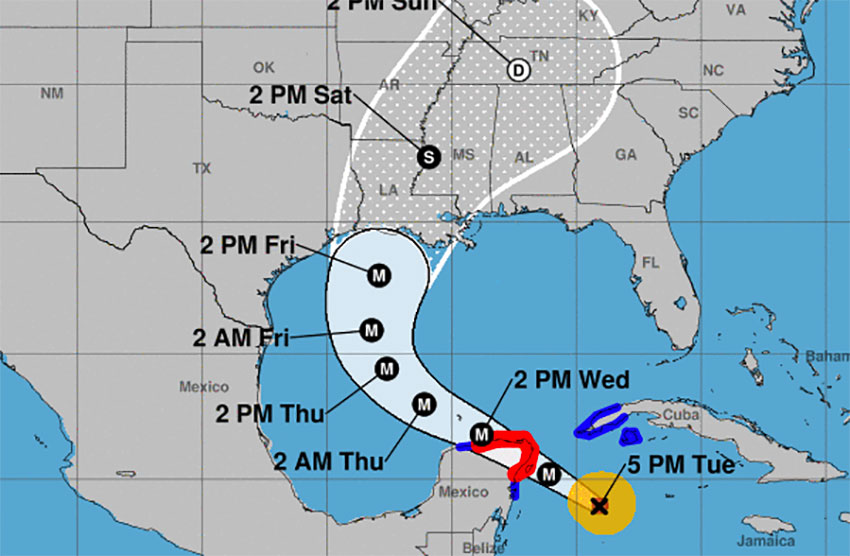With Hurricane Delta approaching the Yucatán Peninsula as a powerful Category 4 storm, authorities have issued a red alert for seven municipalities due to the imminent threat of what the U.S. National Hurricane Center (NHC) has called an “extremely dangerous storm surge and hurricane conditions.”
According to a 4 p.m. CDT advisory from the NHC, Delta is currently located 345 kilometers east-southeast of Cozumel and 385 kilometers east-southeast of Tulum with sustained winds of 230 kilometers per hour.
Meteorologists warn that further strengthening could take place before Delta makes landfall near Puerto Morelos, Quintana Roo, in the early hours of Wednesday morning.
Citizens in Tulum, Solidaridad, Cozumel, Puerto Morelos, Benito Juárez, Isla Mujeres and Lázaro Cárdenas are ordered to stay inside beginning at 5 p.m., and all work has been suspended except for supermarkets which will close at 5, Quintana Roo Governor Carlos Joaquín González announced on Twitter.
A dry law is also in effect in Quintana Roo, banning the sale of alcohol until further notice. Residents are asked to have enough food and water to last three days and should expect the power to go out.

The Federal Electricity Commission has assembled a Delta response team consisting of 650 electrical workers, 113 cranes, 181 vehicles, a helicopter, and 28 emergency generators to address Delta’s potential destruction in Quintana Roo and Yucatán.
President López Obrador sent disaster relief equipment and 5,000 troops to areas expected to suffer the greatest impact from the storm, which was a Category 2 hurricane this morning before rapidly intensifying. Tourists and people in high-risk areas are being evacuated to shelters. Some hotel guests in Quintana Roo are being bused to government shelters located inland.
Tourists — there are currently an estimated 40,900 in the state — may remain in hotels that have been rated for major hurricanes, Accuweather reported.
The Cancún and Cozumel airports will close today at 5 p.m., while the Chetumal and Mérida airports will remain open.
“It is expected to be a dangerous hurricane as soon as it reaches the coast of the peninsula. Its strength as a hurricane has not been seen in the last 15 years,” said Gabriel López Espinoza, director of the National Water Commission (Conagua) in Quintana Roo.
In 2005, Hurricane Wilma hit the peninsula as a Category 4 hurricane, killing eight people and causing US $4.8 billion in damages. Some 98% of hotels in Quintana Roo were damaged or destroyed, including 110 hotels in Cancún.
If the storm follows the current predicted track, it will mainly affect eastern Yucatán, from the port of Río Lagartos to Dzilam de Bravo. Tizimín and Río Lagartos are still reeling from the effects of Tropical Storm Gamma over the weekend, which mainly caused intense rainfall.
Lightning, a two-meter storm surge and up to 254 millimeters of rain are expected to accompany winds of 230 kilometers per hour in northern Quintana Roo and eastern Yucatán as Delta moves across the peninsula to the Gulf of Mexico later on Wednesday.
Hurricane-force winds extend outward up to 45 kilometers from the cyclone’s center and tropical-storm-force winds extend outward up to 165 kilometers, meaning residents of Yucatán and Quintana Roo may experience hurricane-force winds later this evening.
Delta may lose strength in the hours it is over land but should regain strength over warm waters and continue its path northward, where it is expected to make landfall for a second time on Friday in Louisiana. Oil platforms in the Gulf have already begun evacuating workers.
Delta is the 25th named storm of the Atlantic hurricane season, which this year could surpass 2005 as the busiest hurricane season on record in the Atlantic. Hurricane season officially ends on November 30.
Source: Milenio (sp), Infobae (sp)
